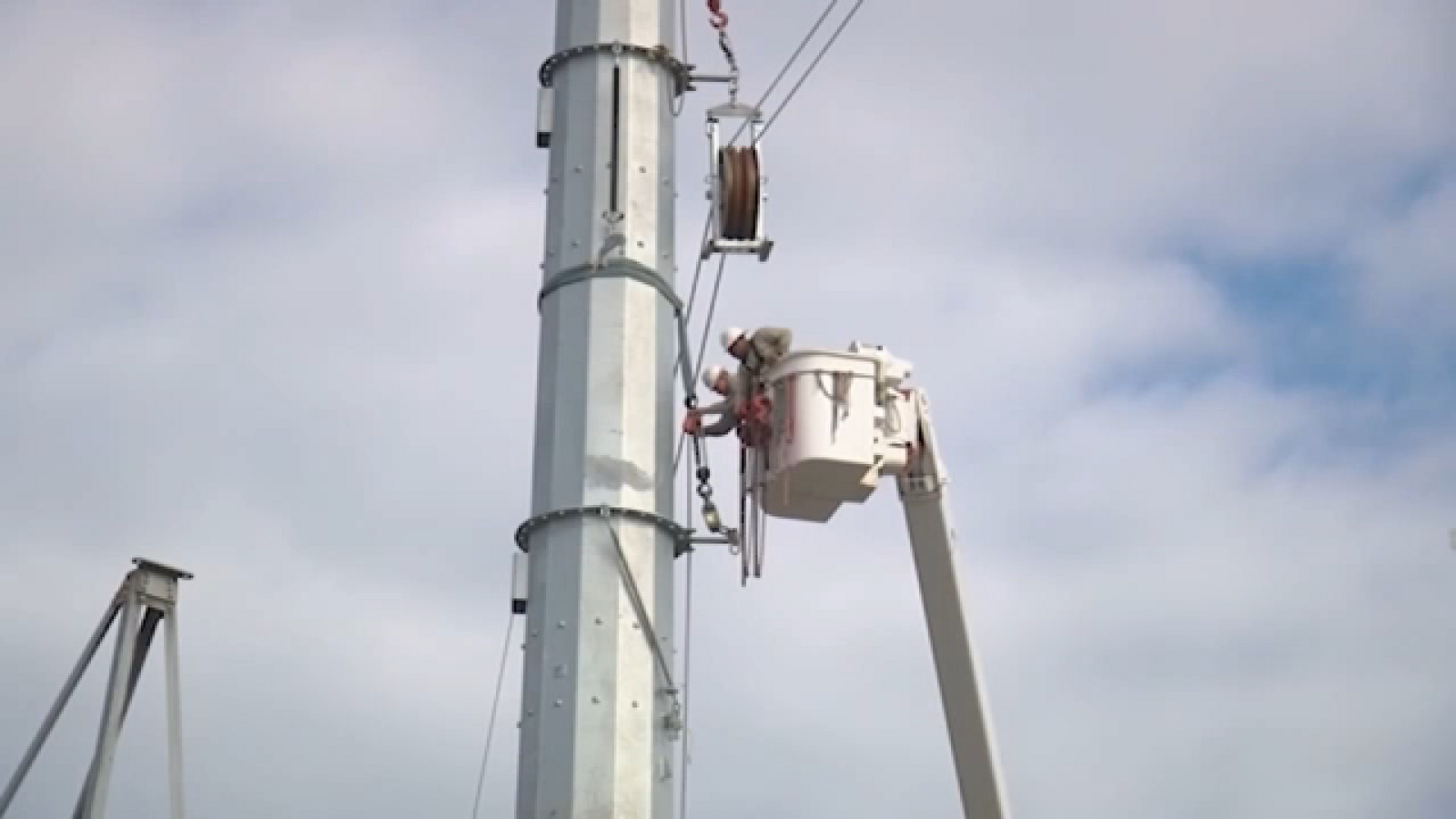Connecting and opening up the nation through infrastructure investment – George W. Bush Presidential Center

Report on U.S. Post-War Infrastructure Development and its Alignment with Sustainable Development Goals
Introduction: Infrastructure as a Catalyst for Sustainable Development
Between 1944 and 1956, the United States executed a comprehensive infrastructure investment program, culminating in the National Interstate and Defense Highways Act of 1956. This initiative, championed by President Dwight D. Eisenhower, fundamentally reshaped the nation’s economic geography and provided a competitive advantage. This report analyzes this historical period through the lens of the United Nations Sustainable Development Goals (SDGs), evaluating how these investments contributed to economic growth, reduced inequalities, and fostered innovation, while also presenting challenges for long-term sustainability.
Historical Analysis of U.S. Infrastructure Investment (Pre-1956)
Early Initiatives and Foundational Gaps
Prior to World War II, U.S. infrastructure development, while significant, resulted in stark regional disparities. Key 19th and early 20th-century projects laid a foundation for economic activity but failed to create equitable national integration.
- Early Projects: The Erie Canal (1825) and the transcontinental railroad network dramatically reduced shipping costs, fostering agricultural and industrial growth, which aligns with the principles of SDG 9 (Industry, Innovation, and Infrastructure).
- Educational Infrastructure: The Morrill Act of 1862 established land-grant colleges, promoting access to education and diffusing agricultural technology, a precursor to the goals of SDG 4 (Quality Education).
- Pre-War Federal Investment: Programs like the 1902 Reclamation Act and the 1936 Rural Electrification Act began to address critical needs in water and energy, reflecting early efforts toward SDG 6 (Clean Water and Sanitation) and SDG 7 (Affordable and Clean Energy).
Geographic Disparities and Inequality
On the eve of World War II, the U.S. South was characterized by significant underdevelopment, highlighting a failure to achieve SDG 10 (Reduced Inequalities). The region lagged in nearly every metric of infrastructure and well-being:
- Energy Access: In the mid-1930s, less than 15% of homes in Mississippi had electricity, compared to over 90% in Massachusetts, demonstrating a profound energy access gap under SDG 7.
- Transportation: The South had few quality roads and lower vehicle ownership, limiting economic participation and contributing to poverty, a challenge related to SDG 1 (No Poverty).
- Health and Education: The region possessed two-thirds of the hospital capacity per capita of wealthier states and only two major research universities, indicating shortfalls in achieving SDG 3 (Good Health and Well-being) and SDG 4.
The Post-War Infrastructure Boom (1944-1956)
A Legislative Framework for Sustainable Growth
Beginning in 1944, a series of federal acts initiated an unprecedented infrastructure expansion, systematically addressing the nation’s development gaps. These acts can be mapped directly to several SDGs:
- Federal-Aid Highway Act (1944): Laid the groundwork for a national highway network, essential for SDG 9.
- Federal Airport Act (1946): Funded a national airport system, enhancing connectivity and commerce in line with SDG 8 (Decent Work and Economic Growth).
- Hill-Burton Act (1946): Supported hospital construction in underserved areas, directly advancing SDG 3.
- Expanded Electrification and Water Projects: Post-war investments raised rural electricity access to 96% by 1956 and expanded water infrastructure, making significant progress on SDG 7 and SDG 6.
The National Interstate and Defense Highways Act of 1956
President Eisenhower’s leadership was instrumental in overcoming political opposition to create the Interstate Highway System. His vision was to build a modern, efficient network to support national defense and economic prosperity. The 1956 Act represented a monumental commitment to SDG 9, authorizing the construction of a 40,000-mile network with the federal government funding 90% of the cost.
Socio-Economic Impacts and Progress Towards Sustainable Development Goals
SDG 10: Reducing Regional Inequalities
The post-war infrastructure boom was arguably most successful in its contribution to SDG 10 by integrating the economically isolated South. The rise of the “Sun Belt” was a direct result of these investments.
- Infrastructure Convergence: By 1960, per capita electricity use in the South matched the Northeast. By 1980, access to safe water and modern plumbing had also reached parity.
- Economic Convergence: Median household incomes in the South rose from 52% of the Northeast’s level in 1940 to approximately 90% by 2023.
- Demographic Shift: The South transformed from a region of net emigration to a magnet for domestic migration, reflecting newfound economic opportunity.
SDG 8 & 9: Fostering Economic Growth and Resilient Infrastructure
The Interstate Highway System was a primary driver of national economic performance, directly supporting the targets of SDG 8 and SDG 9.
- Enhanced Productivity: The system enabled efficient, flexible freight transport, with ton-miles sextupling between 1956 and 2023. This created a highly integrated domestic market that strengthened U.S. firms.
- Industrial Decentralization: Manufacturing, particularly in the automotive sector, expanded into new regions like Alabama and South Carolina, diversifying economic activity.
- Global Market Access: The interstates connected agricultural heartlands to global markets, boosting food exports and strengthening the rural economy.
SDG 11: Reshaping Sustainable Cities and Communities
The impact on SDG 11 was mixed. While the highway system enabled growth, it also created long-term sustainability challenges.
- Positive Impacts: The system facilitated suburban growth and, combined with federal housing loan guarantees, supported a historic homebuilding boom that increased housing affordability for decades.
- Negative Impacts: The construction of highways through urban centers often destroyed low-income, majority-Black neighborhoods, undermining social equity. This model also entrenched car-dependent development patterns, which conflicts with modern goals for sustainable urban mobility and reduced emissions.
Contemporary Challenges and Future Outlook
Maintaining the Infrastructure Edge
In the 21st century, the U.S. faces challenges in maintaining its infrastructure advantage. Federal spending has declined as a share of the economy, and the cost of construction has risen significantly compared to peer nations. This creates risks for continued progress on SDG 9 and SDG 8.
Emerging Demands and Sustainability
New demands require a renewed focus on sustainable and resilient infrastructure.
- Energy Grid: The rise of AI-focused data centers is straining the power grid, highlighting an urgent need for investment in modern, clean energy systems to meet SDG 7.
- Water Systems: Western water systems face deterioration from overuse and climate change, threatening the long-term viability of communities and requiring innovative solutions for SDG 6.
- Regulatory Barriers: Byzantine regulations impede the rapid deployment of new infrastructure, from renewable energy projects to public transit, hindering the nation’s ability to adapt to 21st-century challenges.
Conclusion
The post-war American infrastructure boom serves as a powerful historical example of how targeted, large-scale public investment can drive economic growth and reduce regional inequalities, aligning with the core principles of SDGs 8, 9, and 10. The visionary leadership behind the Interstate Highway Act transformed the nation. However, the legacy also includes challenges related to urban sustainability (SDG 11) and environmental impact. To support future prosperity, the U.S. must adopt a modern approach that prioritizes building resilient, equitable, and environmentally sustainable infrastructure for the future.
Analysis of Sustainable Development Goals in the Article
1. Which SDGs are addressed or connected to the issues highlighted in the article?
The article discusses a massive, post-World War II infrastructure building program in the United States, focusing on its economic and social impacts. This directly connects to several Sustainable Development Goals (SDGs) that address infrastructure, economic growth, inequality, health, education, and access to basic services.
- SDG 3: Good Health and Well-being: The article mentions the Hill-Burton Act of 1946, which supported the construction of thousands of modern hospitals, and the expansion of medical education and schools, which directly contributes to building a resilient health system.
- SDG 4: Quality Education: The text highlights investments in universities and medical schools, such as the land-grant colleges built in the 19th century and the doubling of medical schools post-war, which expanded access to tertiary education and research capabilities.
- SDG 6: Clean Water and Sanitation: The article details significant federal investment in water infrastructure, including the construction of large dams along the Tennessee and Colorado Rivers, which enabled the growth of cities and provided essential water resources.
- SDG 7: Affordable and Clean Energy: The passage of the Rural Electrification Act and subsequent investments are discussed, which dramatically increased access to electricity in rural and underserved areas, particularly in the South.
- SDG 8: Decent Work and Economic Growth: The entire article is framed around how infrastructure investment spurred economic growth, increased productivity, opened up larger domestic markets, and transformed the U.S. economy.
- SDG 9: Industry, Innovation, and Infrastructure: This is the central theme of the article. It extensively details the development of resilient infrastructure, including roads (Interstate Highway Act), airports, telecommunications, and power, and how this supported industrialization and economic competitiveness.
- SDG 10: Reduced Inequalities: A major focus is on how federal infrastructure investments helped close the significant economic and social gaps between the impoverished South and the wealthier regions of the U.S., reducing regional inequality.
- SDG 11: Sustainable Cities and Communities: The article explains how the Interstate Highway System transformed metropolitan areas, powered the rise of suburbs, enabled a historic homebuilding boom, and affected the economic vitality of urban cores.
2. What specific targets under those SDGs can be identified based on the article’s content?
Based on the article’s detailed descriptions, several specific SDG targets can be identified:
- Target 3.c: Substantially increase health financing and the recruitment, development, training and retention of the health workforce in developing countries, especially in least developed countries and small island developing States.
- Explanation: While the U.S. is not a developing country, the principle of investing in the health workforce and facilities in underdeveloped regions is central. The article describes how federal support “roughly doubled the number of medical schools” and led to a “tripling in the number of new physicians graduating each year from 1949 to 1980,” directly addressing the need for more health workers and facilities in underserved areas.
- Target 4.3: By 2030, ensure equal access for all women and men to affordable and quality technical, vocational and tertiary education, including university.
- Explanation: The article highlights the creation of land-grant colleges to “diffuse valuable technologies” and the post-war investment that expanded universities and medical schools, particularly benefiting the underdeveloped South. This effort aimed to equalize access to higher education and research opportunities across the nation.
- Target 6.4: By 2030, substantially increase water-use efficiency across all sectors and ensure sustainable withdrawals and supply of freshwater to address water scarcity.
- Explanation: The article describes the federal government building “large-scale irrigation and hydropower infrastructure” and notes that “Most of the large dams that enabled the growth of Southern and Southwestern cities were built between 1950 and 1980.” This represents a massive effort to manage water resources to support economic and population growth.
- Target 7.1: By 2030, ensure universal access to affordable, reliable and modern energy services.
- Explanation: The article explicitly mentions the 1936 Rural Electrification Act and the subsequent boost in investment, which led to the share of “rural homes with electricity” rising “from just over one-third at the end of the war to 96% by 1956.” This is a direct example of achieving universal energy access.
- Target 8.2: Achieve higher levels of economic productivity through diversification, technological upgrading and innovation.
- Explanation: The article states that the interstate highways generated “large increases in productivity across America’s economy.” By connecting markets and enabling efficient freight movement, the infrastructure boom allowed for economic diversification and enhanced productivity advantages for U.S. companies.
- Target 9.1: Develop quality, reliable, sustainable and resilient infrastructure, including regional and transborder infrastructure, to support economic development and human well-being, with a focus on affordable and equitable access for all.
- Explanation: This is the core subject of the article. The National Interstate and Defense Highways Act of 1956 is described as building the “world’s best ground transportation network.” The text details the construction of roads, airports, power, telecommunications, and water systems, all aimed at supporting economic development and connecting the entire nation.
- Target 10.2: By 2030, empower and promote the social and economic inclusion of all, irrespective of age, sex, disability, race, ethnicity, origin, religion or economic or other status.
- Explanation: A key outcome of the infrastructure boom was closing the gap for the economically excluded South. The article notes that these investments enabled “economically less developed parts of the country – the South, above all – to close many of the enormous economic gaps.” The rise of the Sun Belt is presented as a direct result of this inclusive development.
- Target 11.1: By 2030, ensure access for all to adequate, safe and affordable housing and basic services and upgrade slums.
- Explanation: The article connects the highway system to a “historic homebuilding boom that kept housing relatively affordable for the rest of the 20th century.” This was achieved by expanding commuting ability and opening up previously remote areas for suburban development, thereby increasing the housing supply.
3. Are there any indicators mentioned or implied in the article that can be used to measure progress towards the identified targets?
Yes, the article provides numerous specific statistics and data points that can serve as indicators to measure progress towards the identified targets.
- For Health (Target 3.c):
- The number of medical schools “roughly doubled.”
- The number of “new physicians graduating each year” tripled from 1949 to 1980.
- By 2024, Southern states were home to 12 of the top 50 cancer centers, indicating increased high-quality healthcare capacity.
- For Energy (Target 7.1):
- The percentage of rural homes with electricity rose from “just over one-third at the end of the war to 96% by 1956.”
- Electricity use per capita in Southern states “fully caught up with Northeastern and West Coast levels by 1960.”
- For Economic Growth & Infrastructure (Targets 8.2 & 9.1):
- A “40,000-mile network of major highways” was planned.
- Freight movement, measured in ton-miles, “sextupled from 1956 to 2023.”
- Commercial flights increased “almost 50-fold from 1950 to 1980.”
- For Reduced Inequalities (Target 10.2):
- Average incomes in the South rose from “just 52% [of the Northeast’s level] in 1940” to “about 90% of levels prevailing in the Northeast by 2023.”
- The South’s share of the nation’s population grew from an “all-time low of 28% in 1960” to “39% of the nation’s population” today.
- Access to safe water and modern plumbing in the South “fully caught up by 1980.”
- For Water (Target 6.4):
- The federal budget for water infrastructure “rose more than sixfold by the mid-1950s from its late 1930s level.”
- 16 dams were completed along the Tennessee River between 1933 and 1944.
4. Summary Table of SDGs, Targets, and Indicators
| SDGs | Targets | Indicators |
|---|---|---|
| SDG 3: Good Health and Well-being | 3.c: Increase health financing and workforce. | Number of medical schools doubled; number of new physicians graduating tripled (1949-1980); Southern states home to 12 of top 50 cancer centers by 2024. |
| SDG 4: Quality Education | 4.3: Ensure equal access to tertiary education. | The South’s share of leading research universities became commensurate with its share of the population. |
| SDG 6: Clean Water and Sanitation | 6.4: Increase water-use efficiency and ensure freshwater supply. | Federal budget for water infrastructure rose more than sixfold by the mid-1950s; 16 dams built on Tennessee River (1933-1944). |
| SDG 7: Affordable and Clean Energy | 7.1: Ensure universal access to modern energy. | Share of rural homes with electricity rose from ~33% post-WWII to 96% by 1956. |
| SDG 8: Decent Work and Economic Growth | 8.2: Achieve higher levels of economic productivity. | Freight movement (ton-miles) sextupled from 1956 to 2023. |
| SDG 9: Industry, Innovation and Infrastructure | 9.1: Develop quality, reliable, sustainable and resilient infrastructure. | Construction of a 40,000-mile interstate highway network; commercial flights increased 50-fold (1950-1980). |
| SDG 10: Reduced Inequalities | 10.2: Promote social and economic inclusion. | Median household income in the South rose from 52% of the Northeast’s level in 1940 to 90% by 2023. |
| SDG 11: Sustainable Cities and Communities | 11.1: Ensure access to adequate, safe and affordable housing. | The highway system led to a “historic homebuilding boom that kept housing relatively affordable for the rest of the 20th century.” |
Source: bushcenter.org
What is Your Reaction?
 Like
0
Like
0
 Dislike
0
Dislike
0
 Love
0
Love
0
 Funny
0
Funny
0
 Angry
0
Angry
0
 Sad
0
Sad
0
 Wow
0
Wow
0


















































.jpg.webp?itok=0ZsAnae9#)



/environment-climate-change-and-health-(ech)/water-sanitation-hygiene-and-health-(wsh)/landfill-tuvalu-36092.tmb-1200v.jpg?sfvrsn=5c21fe40_1#)




















